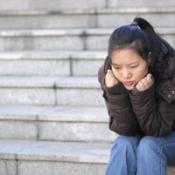 Trauma often leaves us living in a seemingly hostile world, feeling ineffective, believing that help cannot be expected.
Trauma often leaves us living in a seemingly hostile world, feeling ineffective, believing that help cannot be expected.
To some degree, the concept of limited internal power and limitless external power remains an essential component of complex trauma. Fatalism (or “learned helplessness”) is a debilitating side effect of experienced oppression. In many, the freeze response includes disengagement from life—an intentional separation from anger, power, and movement.
Internalized Oppression and the Freeze Response
The human body has a few options when threat is detected. If we look around and find physical signals of safety from another, our anxiety recedes. If support is not available, we move into fight-or-flight mode, mobilizing for self-protection. Especially for children—when physical size renders fight useless and dependence precedes flight—freeze is the next step.
Like fight or flight, freeze is a biological resource. It serves a purpose. It effectively preserves within our core what we deem most fragile and valuable, as if moving into hibernation or hiding in a safe until safety once again presents itself. We lie dormant.
While the mechanism is an effective one, the experience of life in a freeze state is not always pleasant. We still access fight and flight, often more readily than others, as if we are living on the border of that biological response. In fact, we are. As freeze is a drop after fight or flight, the experience of fight/flight becomes the wall between us and the world. Life itself becomes a protected bubble, with little action—sometimes indiscernible movement. Just breathing. Waiting. Sometimes minutes. Sometimes decades.
We live on as a sliver of our whole: eating food, maintaining, avoiding any risks that might bring us closer to whatever dreams we hold. We may carry some fantasy of being recognized or saved one day, or eventually finding courage and overcoming our self-imposed prisons. One major challenge lies in the fact the only route to freedom includes a journey through the impenetrable panic of fight/flight, and we still carry the template of our last experience there. So we end up living—or at least maintaining—in cages of our own making, feeling frustrated, depressed, powerless to escape or change.
This is a form of internalized oppression. On a macro scale, internalized oppression (also known as self-directed oppression) is when a marginalized or oppressed population begins to accept and act on stereotypes and other inaccurate beliefs related to it. On a personal level, internalized oppression happens when we impose limits on ourselves in pursuit of safety.
This is a form of internalized oppression. On a macro scale, internalized oppression (also known as self-directed oppression) is when a marginalized or oppressed population begins to accept and act on stereotypes and other inaccurate beliefs related to it. On a personal level, internalized oppression happens when we impose limits on ourselves in pursuit of safety.
Noticing Our Power
Many of us have seen the violence of power and want no part of it. We divorce from power within ourselves. We feel weak and, at the same time, fear our strength.
When we look from a distance, we see violence and oppression at a global scale. Zooming in, it becomes apparent between cultures and classes. Then, in the family unit, violence presents as abuse (physical, sexual, verbal, etc.) or neglect. Using therapeutic models such as Hakomi therapy or Internal Family Systems, we zoom in still further, witnessing the pain and “stuckness” of internal conflict and oppression.
In simple moments—maybe sitting in a garden or a counseling office—we recognize the power in ourselves. We recognize a conflict as we feel the physical sensation of shifting our awareness between the part that judges/contains and the part being contained. We notice the part contained using anger as a resource to build power, to break our own walls. We realize how dependable and valuable our own containment system has been, and may even feel gratitude noticing that part of ourselves valued us so completely. Maybe we feel the contained part in our throat, moving upward, while the other part—the tension in our shoulders—acts as the dam that holds back forbidden parts of ourselves: the precious and preserved parts.
Leaving the Island
Much like Tom Hanks in the film Cast Away, the island serves as a metaphor for our own self-containment. It is isolating, endlessly frustrating, lonely, and safe. It is a place one could live out a lifetime in the experience of nothingness. The only escape represents potential death … and simple change: the unknown. This is the experience of the freeze state. A giant ocean lies between you and the world, with no direction or guarantee of reaching that life of which you dream.
Reminders, Tips, and Tricks for Overcoming Internalized Oppression
- Anger is a resource.
- Get to know, feel, understand, and trust your body.
- If your head needs information in order to let down its guard, explore some of the leading research in trauma and complex trauma. Peter Levine. Bessel van der Kolk. Pat Ogden.
- Start living in your body—moving away from the judging, analyzing, and planning of your head.
- Take in the feeling of movement. Google “walking meditation.” Explore yoga.
- Take in the good. When things are going well, when you reach a goal, sit and feel your body.
You may notice a sense of overwhelm in considering reaching out for help for internalized oppression. I often recommend simple self-compassion and permission to take things slow. This is gradual exposure to life, building tolerance for change. Even two minutes at a time can help. Consider support groups or one-on-one counseling with a specialist in complex trauma, childhood abuse, or learned helplessness.

The preceding article was solely written by the author named above. Any views and opinions expressed are not necessarily shared by GoodTherapy.org. Questions or concerns about the preceding article can be directed to the author or posted as a comment below.

 From Head to Heart: A Primer for Hakomi Therapy
From Head to Heart: A Primer for Hakomi Therapy The Key Role Your Nervous System Plays in Trauma Recovery
The Key Role Your Nervous System Plays in Trauma Recovery 3 Steps to Healing Trauma that Everyone Should Know
3 Steps to Healing Trauma that Everyone Should Know

Please fill out all required fields to submit your message.
Invalid Email Address.
Please confirm that you are human.
Leave a Comment
By commenting you acknowledge acceptance of GoodTherapy.org's Terms and Conditions of Use.